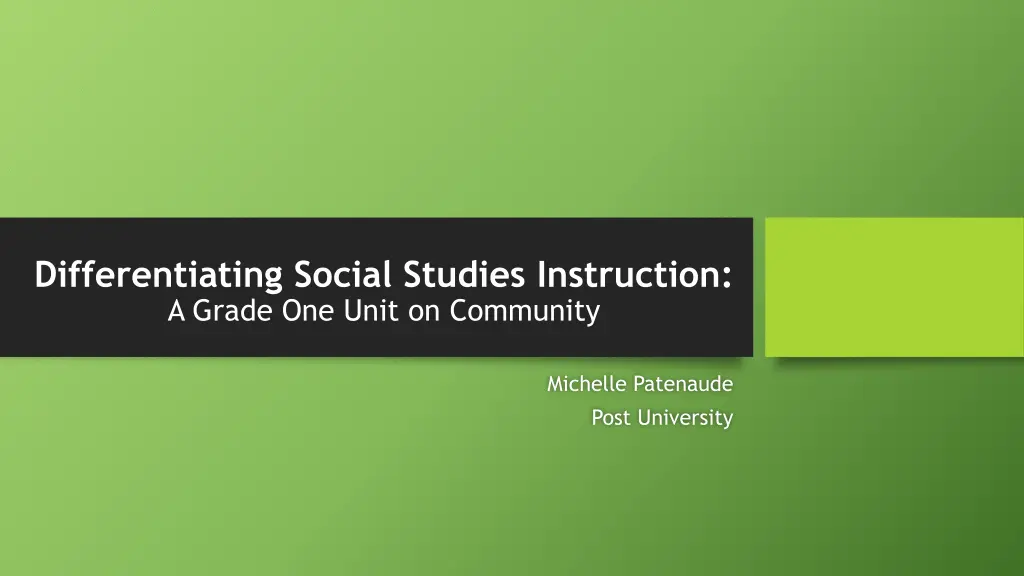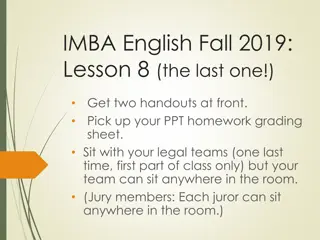
Grade One Community Unit: Social Studies Instruction Differentiation
Explore differentiated social studies instruction for grade one students focusing on the unit about communities. Learn key concepts like geography, economics, and history through various activities tailored to different learning styles and preferences.
Download Presentation

Please find below an Image/Link to download the presentation.
The content on the website is provided AS IS for your information and personal use only. It may not be sold, licensed, or shared on other websites without obtaining consent from the author. If you encounter any issues during the download, it is possible that the publisher has removed the file from their server.
You are allowed to download the files provided on this website for personal or commercial use, subject to the condition that they are used lawfully. All files are the property of their respective owners.
The content on the website is provided AS IS for your information and personal use only. It may not be sold, licensed, or shared on other websites without obtaining consent from the author.
E N D
Presentation Transcript
Differentiating Social Studies Instruction: A Grade One Unit on Community Michelle Patenaude Post University
Educational Context First Grade general education classroom Experienced with differentiating instruction for literacy and math This year, we will implement the new Social Studies Frameworks CT K-8 Social Studies Frameworks Outline common themes, essential questions and core content All students need to access this material to understand the key ideas of citizenship, social skills and cultural awareness
Rationale for Differentiation Content Process Product Essential Social Studies content like geography, economics and history can be accessed in many ways (Mindes, 2015). Tiered activities and questioning can be varied for levels of support Balance choice with teacher direction to encourage students to move beyond their comfort zone (Fitzgerald, 2016). Guidance/Modeling on structured, concrete tasks befor emoving to open-ended, abstract tasks (Tomlinson, 2001). Real-world, authentic inquiries (Mindes, 2015). Personally meaningful to students lives (Tomlinson, 2001). Common expectations for all students (Tomlinson, 2001).
____________________s Learn er Pro file I like to wo rk By m yself With a partner In a group Learner Profile I learn b est b y Listening Seeing Doing Talking Students come to our classrooms with virtual schoolbags : the skills, knowledge and experiences that influence their learning styles and preferences. I like to sh o w m y learn in g b y Drawing Writing Creating Talking Technology I am really g reat at I n eed so m e h elp with (Fitzgerald, 2016, p. 17)
Unit Plan Lesson Sequence Key Questions Standards Addressed Lesson/ Activity Overview EDU 605 Project Guided Discovery: Urban, Suburban, Rural How are communities the same/ different? CCSS.SL1.2 Ask and answer questions about key details (through other media). CCSS.SL1.4 Describe places with relevant details, expressing ideas and feeling clearly CCSS.W.1.8 With guidance from adults, gather information to answer a question. CCSS.RI.1.9 Identify similarities & differences between two texts on the same topic. CCSS.SL.1.1 Participate in collaborative conversations with diverse partners. Students will review images of suburban, urban and rural areas to notice similarities and differences. Pre-Learning Activity Choosing a Focus What makes a community special? After a jigsaw activity, students will choose one region to focus on (rural, suburban or urban) and begin researching that area. Differentiating Content Geography What do maps tell us about the communities we belong to? GEO 1.1 Construct maps, graphs and other representations of familiar places. GEO 1.2 Use maps, graphs, photographs and other representations to describe places and the relationships and interactions that shape them. GEO 1.4 Explain how weather, climate, and other environmental characteristics affect people s lives in places or regions. Students will analyze and/or create maps of a real or pretend section of their chosen region. During-Learning Activity & Differentiating Process Climate How does climate affect peoples lives? Students will analyze how climate, weather and environment affect people s lives in their region. During-Learning Activity & Differentiating Process Economics How do people earn a living in their communities? ECO 1.3 Describe the goods and services that people in a community produce. ECO 1.4 Explain how people earn income. Students will analyze how people in their chosen region earn a living. During-Learning Activity & Differentiating Process Creating a Product What makes a community special? CCSS.W.1.8 With guidance from adults, gather information to answer a question. CCSS.SL1.4 Describe places with relevant details, expressing ideas and feelings clearly. Students will create a product to demonstrate their understanding of key geographical, environmental and economical features of their region. Post-Learning Activity & Differentiating Product
Pre-Learning Activity: Differentiating Content Nam es:_________________________________ Write 4 sentences about the im age you see. ______________________________________. Nam es:_________________________________ Write 5 sentences about the im age you see. I see __________________________________. Nam es:_________________________________ Com pare and Contrast the two im ages you see. Im age A Image of One Type of Community Image of One Type of Community (Suburban, Urban or Rural) without its respective label (Suburban, Urban or Rural) without its respective label Image of One Type of Community Im age B (Suburban, Urban or Rural) without its respective label ______________________________________. ______________________________________. ______________________________________. I see __________________________________. Make one in feren ce about the im age you see. Make an inferen ce about one difference you noticed. I see __________________________________. Picture A has ___________________________, but Picture B has____________________________. I see __________________________________. I see __________________________________. This m ight m ean___________________________. This m ight m ean __________________________________. I see __________________________________.
During-Learning Activities: Differentiating Process Nam e:_______________________________________ Co m m u n ity BINGO Each day, you will chose one activity. You will com plete each activity on your chosen type of com m unity and within your chosen group. By the end of our unit, you m ust have 4-in-a-row, either acro ss o r d o wn (not diagonal!). Cross off each activity as you com plete it! Balance teacher- directed and student- chosen activities (Tomlinson, 2001). Exp lo re Go o g le Earth Draw a p ictu re with lab els Watch a Natio n al Geo g rap h ic vid eo Lo o k at p h o to g rap h s Co n d u ct an In terview Read fictio n Write a letter Create a Pad let Open-ended activites based around an essential question mimic real-world, authentic learning tasks (Mindes, 2015). Read n o n fictio n Watch a Brain POP vid eo Create a 2-D m ap Read Po etry Create a Pad let Bu ild a 3-D m ap Read n o n fictio n Lo o k at a m ap
Post-Learning Activity: Differentiating Product Keep Wo rkin g ! 1 Po in t I chose one type of com m unity. Go o d Effo rt! 2 Po in ts I chose one type of com m unity and included the correct term (suburban, urban or rural). Excellen t! 3 Po in ts I chose one type of com m unity, included the correct term , and gave one specific exam ple of this com m unity in CT. I showed or explained 3 com m unity helpers / workers in m y com m unity. I showed or explained 3 types of geographical features in m y com m unity. I showed or explained 3 ways weather & clim ate affects m y com m unity. I showed or explained 3 ways m oney is earned or spent in m y com m unity. My product had few/ no m istakes, I practiced showing/ explaining m y product, and m y product dem onstrates inform ation from the unit. Fo cu s Po p u latio n I showed or explained 1 com m unity helper / worker in m y com m unity. I showed or explained 1 type of geographical features in m y com m unity. I showed or explained 1 way weather & clim ate affects m y com m unity. I showed or explained 1 way m oney is earned or spent in m y com m unity. My product had m istakes, I didn t practice showing/ explaining m y product, and m y product doesn t dem onstrate inform ation from the unit. I showed or explained 2 com m unity helpers / workers in m y com m unity. I showed or explained 2 types of geographical features in m y com m unity. I showed or explained 2 ways weather & clim ate affects m y com m unity. I showed or explained 2 ways m oney is earned or spent in m y com m unity. My product had few m istakes, but I didn t practice showing/ explaining m y product, and/ or m y product didn t dem onstrate inform ation from the unit. Student choice can be balanced with core expectations (Tomlinson, 2001). Geo g rap h y Clim ate Rubrics show varying levels of mastery; students are more likely to strive for the highest level (Goodwin & Hubbell, 2013). Eco n o m ics Pro d u ct Qu ality Total: ___ / 18
Additional Differentiation Strategies Interest Groups Flexible groups of students investigating a similar topic (Tomlinson, 2001). Parent volunteers For example, police officers. Graphic Organizers Pre-made forms available to students in an accessible location Students social studies questions should evolve as their investigations grow, so they ll need to keep track of their ideas (Mindes, 2015).
Future Goals and Summary 1. Collaborate with outside colleagues Reading Rockets 2. Differentiation for ELL students ELL Differentiation Strategies 3. Technology to Differentiate CSDE Technology Resources
References Access Center (2004). Differentiated Instruction for Reading. Retrieved from Reading Rockets website: http://www.readingrockets.org/article/differentiated-instruction-reading Connecticut State Department of Education (2015). Connecticut Elementary and Secondary Social Studies Frameworks. Retrieved from CDSE website: http://www.sde.ct.gov/sde/lib/sde/pdf/board/ssframeworks.pdf Connecticut State Department of Education (n.d.). Websites and Apps That Support Differentiated Instruction. Retrieved from CSDE website: http://www.sde.ct.gov/sde/lib/sde/pdf/curriculum/cali/di_websites_chart.pdf Fitzgerald, P. (2016). Differentiation for All Literacy levels in Mainstream Classrooms. Literacy Learning: The Middle Years, 24(2). 17-25. Retrieved from EBSCO host database. Goodwin, B., & Ross Hubbell, B. (2013). The 12 touchstones of good teaching: A Checklist for staying focused every day. Alexandria, VA: ASCD. Mindes, G. (2015). Pushing Up the Social Studies from Early Childhood Education to the World. Young Children, 70 (3). 10-14. Retrieved from EBSCO host database. Sternberg, R. J., & Li-Fang, Z. (2005). Styles of thinking as a basis of differentiated instruction. Theory Into Practice, 44(3), 245 253. doi:10.1207/s15430421tip4403_9 Tomlinson, C. A. (2001). How to differentiate instruction in mixed-ability classrooms. Alexandria, Va: Association for Supervision and Curriculum Development. Vawter, D.H. & Costner, K.M. (November 2013). Differentiating Instruction for ELLS: The Core Tenets of Differentiation Should Guide Our Education of ELLS. Retrieved from the Association for Middle Level Education website: https://www.amle.org/BrowsebyTopic/WhatsNew/WNDet/TabId/270/ArtMID/888/ArticleID/350/Differentiati ng-Instruction-for-ELLs.aspx





















